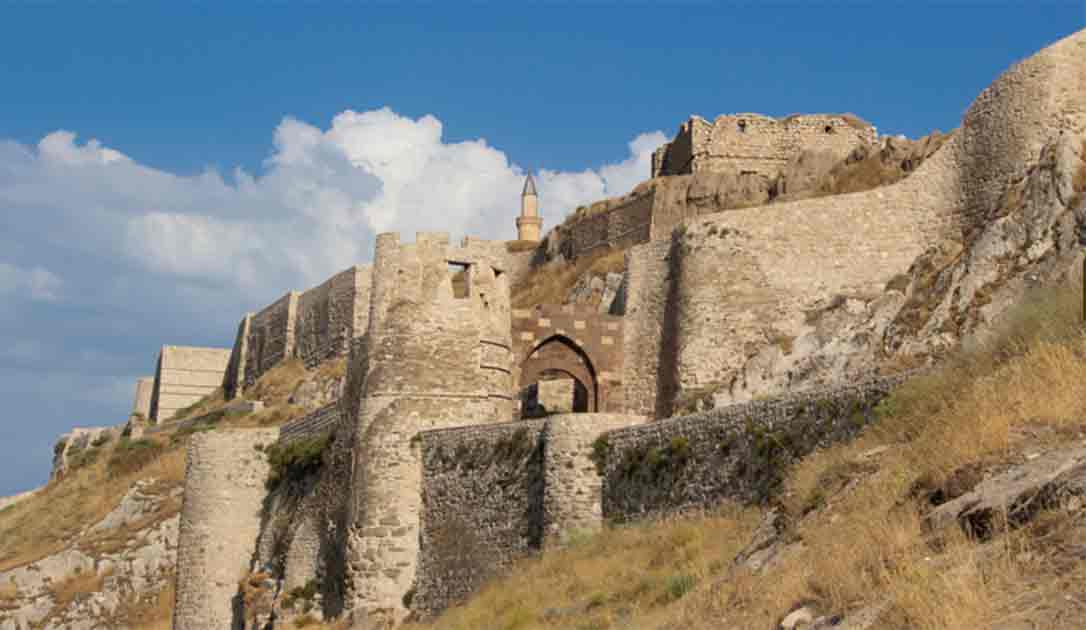The Forgotten Kingdom of Urartu: From Prosperity to Fall
The Kingdom of Urartu, a once significant ancient civilization nestled in the rugged terrain of the Armenian Highlands, flourished from the 9th to 6th centuries BC. Often overshadowed by its Mesopotamian and Egyptian counterparts, Urartu commanded a powerful presence, leaving behind a legacy rich in military prowess, architectural marvels, and cultural achievements. Spanning parts of modern-day Armenia, Turkey, and Iran, its capital, Tushpa (modern-day Van), stood as a show of its grandeur. Despite its eventual demise, Urartu's influence on subsequent civilizations, including the Achaemenid Persian Empire, echoes through history.
- Two Incredibly Old Rock-Carved Urartian Temples Identified in Turkey
- Researchers Discover Ancient Urartian Castle in Eastern Turkey
Origins and Growth of Urartu
Urartu as an independent state first seems to have appeared around the 9th century BC. Its origins, however, stretch back much further. According to Assyrian inscriptions dating back to around 1200 BC, the name Uruatri originally referred to one of the states of Nairi. This was a confederation of small kingdoms and tribes located in the Armenian Highlands between the 14th and 11th centuries BC.
The Nairi states were conquered by Assyrian king Shalmaneser I (1274 BC) and later repeatedly attacked by the Middle and Neo-Assyrian Empires. It seems eventually these kingdoms tired of constant invasions and merged in the 9th century BC to form the kingdom of Urartu. Their first king was Arame of Urartu who founded his first capital at Sugunia and then a second at Arashkun. Unfortunately, the Neo-Assyrian emperor Shalmaneser III captured both of these.
- Necropolis in Turkey Reveals the Iron Age Burial Customs of the Urartu
- The Fascinating Lchashen Settlement, Armenia: Where Elite Warriors Emerged from a Watery Grave
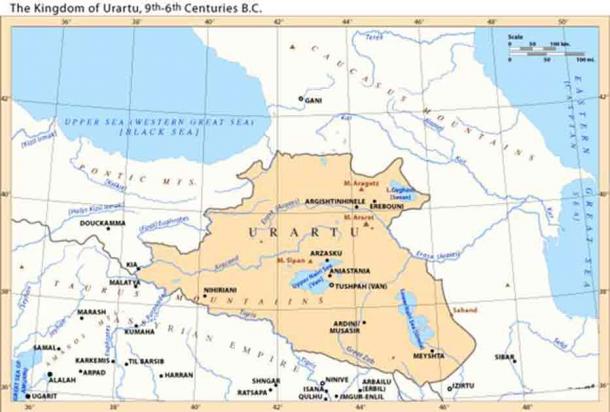
Map of the great Kingdom of Urartu. (İbrahim and the Indo-Europeanizing are/CC BY-SA 4.0)
Despite these setbacks, the kingdom quickly grew in power. It was mainly settled on a very fertile plateau that was well irrigated by rivers. Agriculture thrived and the kingdom became a major producer of wheat, barley, millet, rye, sesame, and flax. On top of this, the region was also one of the earliest in history to make wine, and the remains of plum, apples, cherry, quince, and pomegranate orchards have been found in the region.
Animal husbandry was also popular. Extensive mountain pastures allowed for the raising of sheep, goats, cattle, and horses. Of these, the kingdom was particularly famous for raising some of the finest horses on the continent. The mountains were also home to healthy gold, silver, copper, lead, iron, and tin deposits meaning mining boomed.
Better still, the Kingdom of Urartu was well-placed for trade. Located between the ancient Mediterranean and Asian and Anatolian cultures, Urartu sat on major trade routes.
Urartu had largely been founded as an answer to Assyrian aggression but during the early half of the 9th century BC Assyria was going through a temporary period of stagnation. While its enemy struggled, Urartu’s multiple advantages meant it rapidly became one of the most powerful states in the region.
One of its first kings, Sarduri I (832-820 BC) spent his reign resisting Assyrian attacks coming from the South, Urartu’s neighbors were no fools and despite mountains in the north and south forming natural defenses the kingdom had to get used to its enemies trying to take the kingdom’s wealth. Sarduri not only repelled the Assyrian attacks but consolidated Urartu’s military strength and founded a new capital, Tushapa (modern-day Van in Türkiye).
Sarduri’s son, Ispuini, was just as successful and invaded the neighboring state of Musasir (which later became a major religious center for the kingdom). His successor, Menua, then expanded the kingdom's borders even further. By the reign of Menua’s son, Argishti I (785-760 BC), the kingdom was one of the most powerful in the Near East. Agrishti continued the trend of expansion and repeatedly put down invasion attempts made by the latest Assyrian king, Shalmaneser IV.
At its peak, the Kingdom of Urartu covered parts of modern-day Armenia, eastern Türkiye, and northwestern Iran. Its territory extended from the Caucasus Mountains in the north to the Lake Urmia region in the south, encompassing areas around the Lake Van basin and stretching towards the upper reaches of the Tigris and Euphrates rivers in the west and the east, respectively.
The Urartu Monarchy and Governance
Urartu’s government had a central monarchy that ruled with the help of a close group of advisors. While these rulers looked at the big picture, day-to-day life was governed by a large group of civil administrators. These men were responsible for overseeing the kingdom’s temples and major construction projects like roads, canals, and fortresses.
The kingdom’s longest-lasting capital, Tushpa, was a fortress city located on the eastern shores of Lake Van, modern-day Türkiye’s largest lake. At its peak, Tushpa’s name was changed to Van, and was home to around 50,000 people. The city’s crown jewel was a stunning royal necropolis carved out of the mountain on which the city rested.
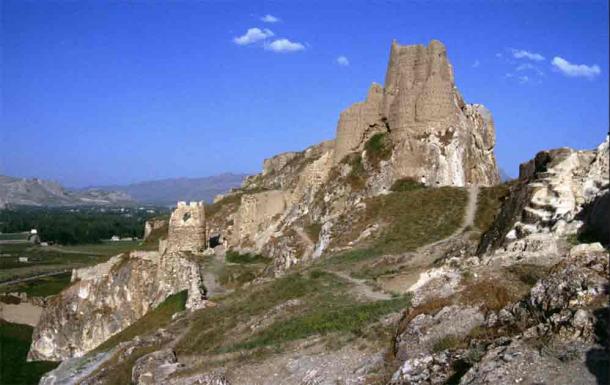
The fortress Tushpa (Van), capital of Urartu, 9th-6th century BC. It sits by Lake Van in eastern Turkey. (Ziegler175/CC BY-SA 4.0)
Outside of the capital each region had its own governor. These governors answered to the king and oversaw justice and tax collection in their respective areas. These taxes were then funneled back to the capital and the crown.
As already mentioned, the kingdom’s unifier and first king was Arame who ruled from 860 until 840 BC. The kingdom then underwent a period of massive growth under Sarudri I, whose king ruled for the next 200 years. During this period two more major cities were founded. Urartu’s second city, Argishtihinili (later renamed Armavir) was founded in 776 BC by Argisti I, and in 685 BC Rusa II built Teishebaini. Over time other centers like Bastam, Karmir Blur, and Ayanis also cropped up.
It wasn’t all sunshine and rainbows, however, and Urartu’s kings could be ruthless. Much of the kingdom’s agriculture was state-controlled and featured land that had been captured by the nation’s army. If neighboring tribes were lucky, they would be allowed to join the confederation at the cost of an annual tribute in the form of goods and slaves.
The alternative was bloody conquest. Urartu wasn’t above enslaving its neighbors by force, and Argishti I seized slaves during his wars against the Hatti during the 780s BC. Records show during these campaigns he captured as many as 320,000 slaves.
A Well-Funded Military
This brings us nicely to Urartu’s army. It’s believed the warlike Urartu kings led their armies personally in times of war. Weaponry is thought to have consisted of iron and bronze swords as well as spears, javelins, and bows. All of which were fairly standard for the time and place.
The military’s most impressive armaments were probably the Urartu’s shields and armor. Troops used heavy shields that featured large central engravings of mythical creatures alongside bulls and lions. Elite troops also wore reinforced helmets and metal scale armor that offered excellent protection but would have been extremely expensive.

Urartian bronze quiver with chariots motif that once belonged to Sarduri II, 764–735 BC, at The Hermitage Museum. (EvgenyGenkin/CC BY-SA 3.0)
The army itself is thought to have peaked at maybe 120,000 men strong. Its numbers were made up of both free citizens and conscripted men. The kingdom's military strength relied on conscription, where able-bodied men were required to serve in the army, as well as on professional soldiers trained for combat.
Furthermore, vassal states and allied territories might have been obligated to provide military support, contributing to the overall manpower of the Urartian army. There is also evidence that the kingdom relied on foreign mercenaries to bolster its ranks, especially in later years as its strength began to wane thanks to decades of constant warfare.
Urartu’s military is also believed to have made clever use of charioteers. The kingdom was famous for its horses and its primary enemy, the Neo-Assyrian Empire was famous for its use of this technology. It seems unlikely that the Urartu wouldn’t have copied them.
The Kingdom of Urartu’s military enjoyed its fair share of victories over the Assyrians. The mid-8th century was particularly eventful with the kingdom giving its old enemy a bloody nose in several battles. Unfortunately for the Urartu, the Assyrians didn’t stay down for long and came back strong.
The Assyrian ruler Tiglath-Pileser III proved to be particularly troublesome. Urartu had grown during a period of Assyrian stagnation and Tiglath was the first enemy king to give the Urartu a real challenge. He was more aggressive than his predecessors and managed to lay siege to the Urartu capital. In 714 BC Sargon II also enjoyed success against Urartu.
When the Assyrians weren’t causing them trouble, the Kingdom of Urartu had the Cimmerians, Scythians, and Medes to contend with. All told the kingdom saw precious few periods of peace and was at war for much of its existence.
Religion in the Kingdom of Urartu
The Urartu people worshiped a mixed pantheon of gods. Some were uniquely Hurrian gods while others came from the Akkadian, Armenian, and Hittite pantheons. In the mid-9th century BC, King Pishpuni encouraged the worship of a triad led by the supreme god Haldi, along with Theispas (the god of storms, war, and thunder) and Shivini (a sun god).
As the lead god Haldi often had temples built in his honor, recognized by their square towers. He was so central to the Urartians that they became known as the Haldians or “children of Haldi.”
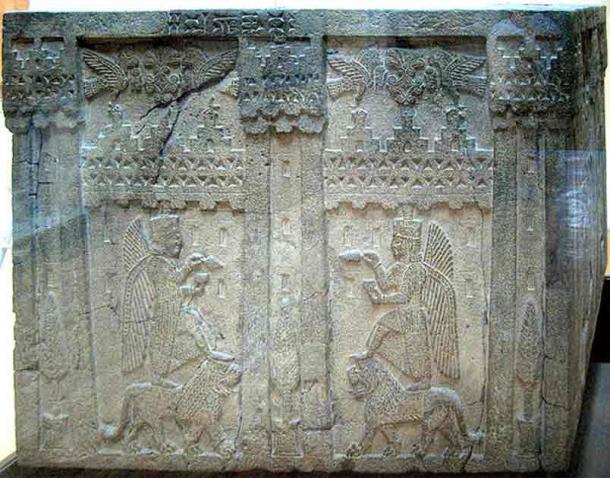
Column base: the god Khaldi stands on a lion, holding in his left hand a bowl and in his right hand a spearhead (or a plant) Reign of King Rusa II (685–645 BC); Urartu; Museum of Anatolian Civilizations, Ankara. (Public Domain)
The religion was, of course, led by the king who served as chief priest and “servant of Haldi.” All wars fought by the Urartians were in Haldi’s name and honor. The gods were also honored in the form of offerings like food, weapons, wines, and expensive goods as well as animal sacrifices.
Similar to how the Romans would later do things, as the Urartians expanded they incorporated the gods of their conquered peoples into their pantheon. This served as a means of confirming the annexation of new territories and ensured stability within the kingdom.
Culture
We can tell that Urartu was a particularly prosperous kingdom by what it left behind- especially in the form of art, pottery, religious dedications, and metalworking. When it comes to art sadly no large-scale stone sculptures have survived, only fragments. Archaeologists have, however, had more luck with other art forms.
Excavations of both public buildings and homes have revealed beautiful wall paintings. Usually painted directly onto plaster, those that survive depict scenes of animals, mythical creatures, the gods, and scenes from day-to-day life. The background of these pictures is normally white with the figures drawn with black outlines, making heavy use of blue and red.
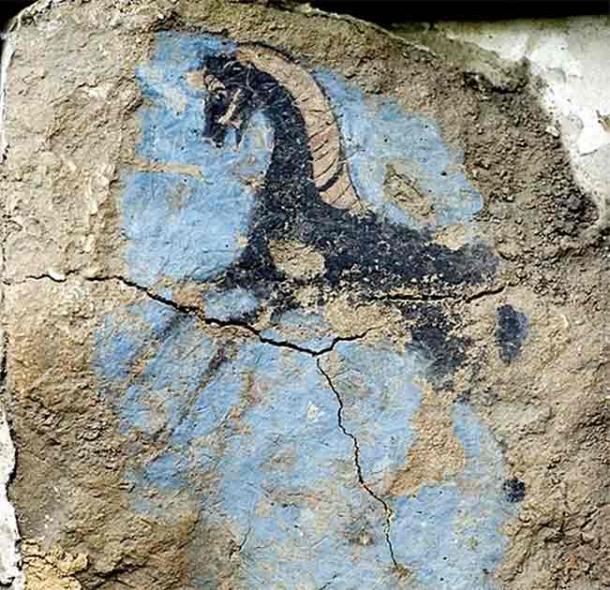
An old Urartian Fresco shows a horse, in the Erebuni Museum, Armenia. (EvgenyGenkin/CC BY-SA 3.0)
The region also has a long history of metalworking (dating back to the 10th century BC), and this is reflected in Urartu’s culture and artworks. The kingdom was home to skilled artisans who produced everything from gold jewelry to horse bits, helmets, buckles, and intricate candelabras smelted from bronze and copper.
While no stone sculptures survived, plenty of bronze ones have. These show that despite being enemies, the Assyrians heavily influenced Urartu’s art. This can be seen in the choice of topics - lions, bulls, griffins, etc. As a nation with a strong military, it should also not be surprising to learn that military themes, especially horse riders, are prevalent as a theme in Urartian art.
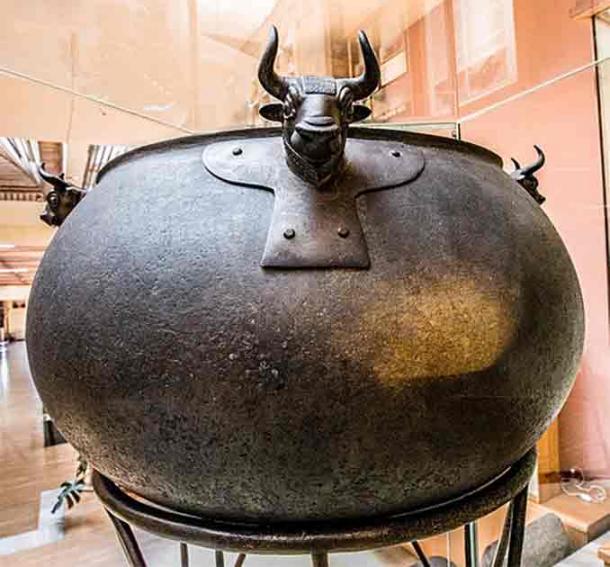
A Urartian cauldron from the Museum of Anatolian civilizations, Ankara. (EvgenyGenkin/CC BY-SA 3.0)
Religious art was also a large part of Urartu’s culture. The main gods were often represented as bronze figurines while the lesser deities were usually carved out of bone. These now-nameless deities can be quite disturbing to behold, taking the form of human-animal hybrids like scorpion-man and fish-man.
As for language, in the beginning, the Urartians wrote using simple pictograms but over time adopted cuneiform from the Mesopotamians. Their language itself appears to be related to Hurrian with the two languages most likely sharing a common ancestor. While most of Urartian culture was lost following its fall, its language proved to be surprisingly long-lasting.
Decline and Fall of a Prosperous Kingdom
Despite all its prosperity, the Kingdom of Urartu was relatively short-lived. At some point between the late 7th and early 6th centuries BC the kingdom came to an incredibly bloody but also mysterious end. No one is sure what exactly happened.
It’s believed the Urartu’s decline began thanks to its near-constant warfare with the Assyrians, which gradually wore the kingdom down and emptied its coffers. This probably forced the kingdom to keep expanding until it began to overstretch itself. At some point, a new force came along and delivered the killing blow.
Who exactly that force was is unknown. We do know that towards its end both the Scythians and Cimmerians were attacking the kingdom. Between 640 and 590 BC, most of Urartu's cities were destroyed.
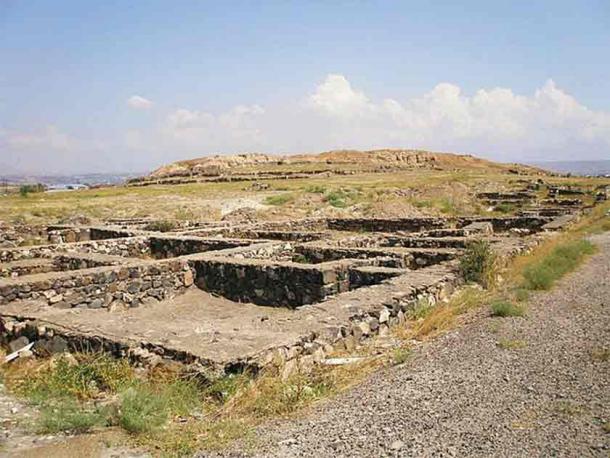
Foundations of the ancient towns near Teishebaini of the ancient kingdom of Urartu. (Liveon001 Travis Witt/CC BY-SA 3.0)
Three-pronged arrowheads found at the devastated city of Teishebaini suggest that Scythian archers had attacked the city. The city had been burned to the ground but seemed to have been the victim of a surprise attack- its granaries had been recently filled and weapons and valuable belongings were abandoned.

Spear heads found at Teishebaini on display at the Erebuni Museum, Yerevan, Armenia. (gegman/CC BY-SA 3.0)
Rather than one enemy, one theory supposes that as the empire weakened, different enemies picked off its cities over two or three decades. From 585 BC the Medes, allies of the Scythians, were in control of most of Urartu’s old territories. They were then brought into the Achaemenid Empire under Cyrus the Great during the mid-sixth century BC.
Conclusion
After this, the Kingdom of Urartu vanished from common memory. All that remained was its language, which survived into Hellenistic times. Town names lasted even longer, and some are still in use to this day.
Urartu remained forgotten until the 19th century when archaeological excavations unearthed its magnificent cities, temples, and artifacts, thrusting Urartu back into the spotlight and highlighting its significance as a prominent regional Bronze Age culture. Through these discoveries, Urartu's legacy endures, offering invaluable insights into the complexities of ancient societies and enriching our understanding of the human experience.
Top image: Van Fortress or Castle of Van, is a massive stone fortification built by the ancient kingdom of Urartu. Source: seyfullah/Adobe Stock
References
Cartwright. M. 2018. Urartu Civilization. Available at: https://www.worldhistory.org/Urartu_Civilization/
Editors. 2024. Urartu. Available at: https://www.britannica.com/place/Urartu
Piotrovsky, B.P. 1969. The Ancient Civilization of Urartu. Cowles Book Co.
Department of Ancient Near Eastern Art. 2004. Urartu - An Essay. Available at: https://www.metmuseum.org/toah/hd/urar/hd_urar.htm
















